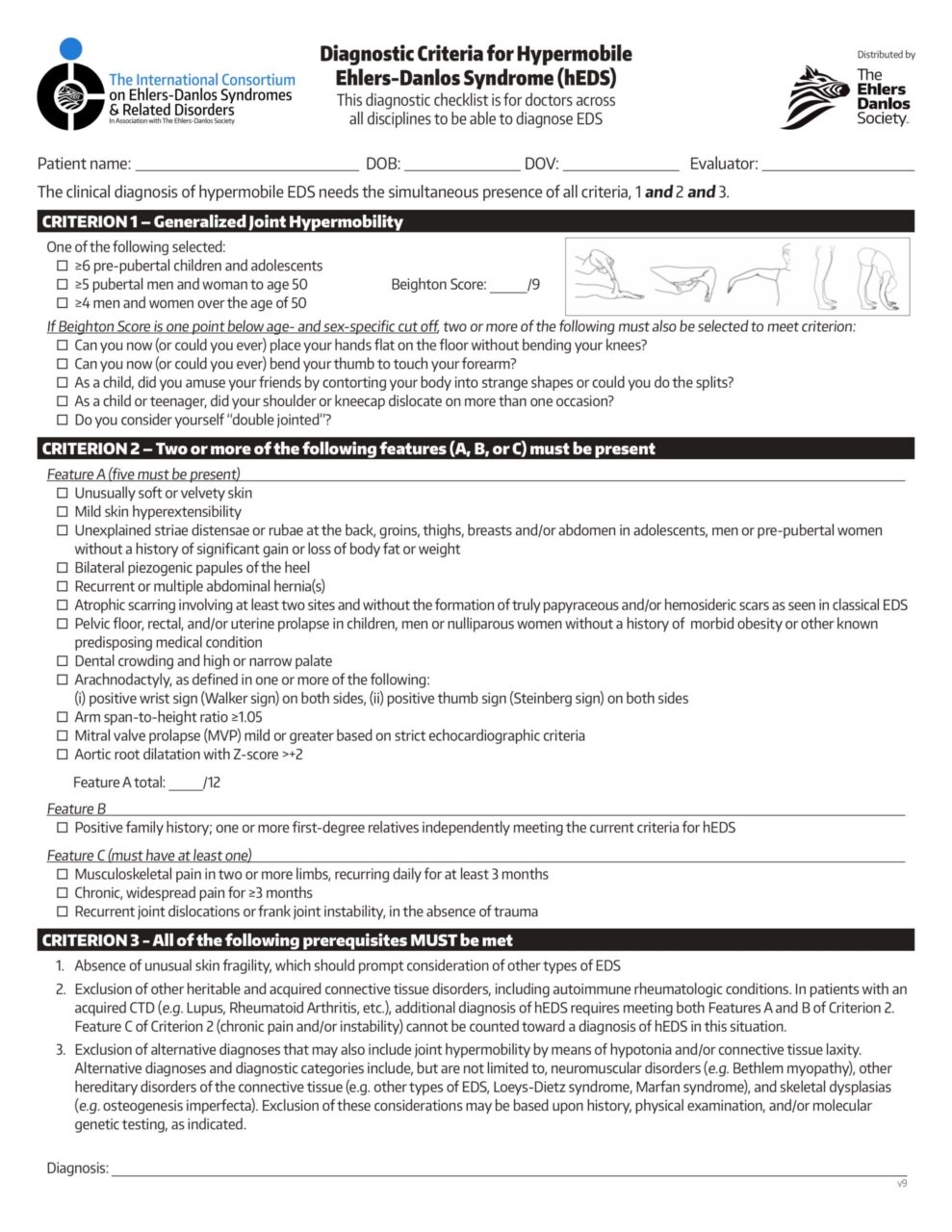Ehlers Danlos Syndrome (EDS) is a genetic connective-tissue disorder that affects the way the body produces proteins like collagen.
In EDS, certain genetic variants disrupt collagen production and processing and prevent the body from assembling it correctly. Consequently, this results in weaker collagen, which then makes weaker connective tissues.
Given that about a third of the body is made of collagen, it goes without saying that a condition which causes weakened collagen would negatively affect much of the body.
There are 13 types of EDS, categorized by their respective genetic mutations and clinical presentations.
The most common type is Hypermobile EDS (hEDS), followed by Classical EDS (cEDS).
Some symptoms of EDS include:
- Hypermobile joints that subluxate (partially dislocate) and dislocate easily
- Craniocervical instability
- Joint pain
- Chronic, widespread pain
- Chronic headaches and migraines
- TMJ disorder
- Chronic fatigue
- Stretchy, fragile skin that is easily bruised and slow to heal
- Multifaceted digestive problems
- Extensive dental problems
A study completed in 2010 theorized that people with EDS go through three different stages of the condition throughout their lifetime – a hypermobile phase, a pain phase, and a stiffness phase.
The results of the study showed that it is common in children with EDS to have more limited pain symptoms, such as growing pains in their legs or fatigue in their hands, but to be extremely flexible or “double-jointed” – signs of hypermobility. This can mean signs of EDS are missed in children, and they may not be diagnosed until their teen years or adulthood, when the symptoms become more pronounced.
Typically, chronic pain, headaches, fatigue, digestive problems, and more set in sometime between the second and fourth decades of life, often leading to diagnoses like Fibromyagia or Chronic Fatigue Syndrome.
The study showed that fewer people reach a stiffness phase, but it does happen to some later in life. The symptoms of the pain phase often continue, while joints become increasingly stiff and immobile (source).
Some people with Ehlers Danlos Syndrome also have POTS, because EDS can affect a person’s blood vessels, among many other bodily tissues. Both these conditions occur frequently alongside Mast Cell Activation Syndrome. Sometimes the three are together called “the trifecta”.
People with EDS are also more likely to have Chiari malformation, a brain abnormality in which part of the lower brain pushes into part of the spinal canal. The craniocervical instability often seen in EDS can exacerbate the symptoms of Chiari malformation, so it can be a vicious cycle when the two occur together.
Both conventional medical doctors and complementary and alternative medicine practitioners notoriously have little to no knowledge about Ehlers Danlos Syndrome.
For many people, this makes it incredibly difficult to get a a diagnosis and effective treatment.
For chronically ill people who suspect EDS, it is possible to screen yourself based on the diagnostic critera for EDS to see if pursuing a specialist could be worthwhile.
The diagnostic criteria for Ehlers Danlos Syndrome include:

- A positive Beighton Score
- Five features of Ehlers Danlos Syndrome; a first-degree relative with Ehlers Danlos Syndrome; or joint instability, chronic widespread pain, or chronic musculoskeletal pain
- Ruling out other possible diagnoses first
12 of the 13 types of EDS have genetic variants associated with them, but research is still being done to determine which genetic variants may be responsible for Hypermobile EDS.
For types of Ehlers Danlos Syndrome other than Hypermobile, genetic testing can be done to help confirm a diagnosis.
If you have already had a home genetic test, depending on the company, you can search your raw data for mutations in these variants.
If you check all of the boxes on the EDS diagnostic criteria and/or find genetic mutations in EDS variants in your raw data, you may be wondering – now what?
Since so many medical providers DON’T know about Ehlers Danlos Syndrome, how are you supposed to find a provider who does?
The Ehler’s Danlos Society provides a directory where you can search for healthcare professionals who are knowledgeable about EDS.
Additionally, the EDS Clinic provides evaluation, diagnosis, and treatment for EDS via telehealth.
But what about treatment? What are the options?
Ehlers Danlos Syndrome can severely weaken the tissues of the body and cause many debilitating symptoms, so it often requires complex treatment across several specialities.
This can include treatment like pharmaceutical symptom management and surgery from medical specialists, as well as physical therapy, chiropractic or osteopathic care, braces, regenerative medicine, and supplements/herbal medicine from other types of providers.
We’ll cover a few of these therapies before the end of this blog post, but first, let’s talk about the Cusack Protocol for Ehlers Danlos Syndrome.
What is the Cusack Protocol for Ehlers Danlos Syndrome?
The Cusack Protocol is a supplement regimen created by Deborah Cusack, a mother of a whole family with Ehlers Danlos Syndrome. She designed the protocol for her family to improve symptoms caused by the disease and provide support for the affected organs of the body.
This includes the gut microbiome, immune system, epitheliums of all organ systems, connective tissue collagen, central and periphreal nervous system myelin, endothelial cells of all organ systems, bones, muscles, vagus nerve, and dentin.
There has been some controversy surrounding the protocol, because there are no large-scale studies done on the entire protocol.
However, as we know, large-scale studies done on any supplement or herbal medicine are few and far between, because these types of large studies are typically funded by the pharmaceutical industry.
That doesn’t mean supplements and herbal medicine don’t work, it simply means there is not a lot of available scientific data from clinical trials. Because supplements and herbal medicine are not profitable for the pharmaceutical industry, little research is done on them.
However, we can look at smaller studies that have been done on the individual components of the protocol. We can also take into account the chemical constituents of the supplements and herbs that give them the medicinal properties they have.
Additionally, we can consider the personal experiences of people with Ehlers Danlos Syndrome who have tried the Cusack Protocol. While personal experience can’t be applied to a population like the results of studies can, that doesn’t mean people’s experiences hold no value at all when deciding whether to try something for yourself.
You can join the Cuscack Protocol for Ehlers Danlos Syndrome Facebook Group to hear from other people with EDS who are taking or have taken the Cusack Protocol to help manage their condition.
So, what’s included in the Cusack Protocol?
The Cusack Protocol for Ehlers Danlos Syndrome
When you take supplements on a regular basis, it’s important to have a convenient place where you can purchase them all at one time. My priorities when searching for a company like this were pricing, selection, and free shipping. I ended up choosing iHerb! They have a huge selection of products, competitive pricing, and free shipping on orders over $30, without a subscription fee. As a bonus, iHerb offers global shipping and currently ships to 185 different countries.
L. Rhamnosus (1-4 capsules daily)
L. Rhamnosus in the protocol provides immune support by building beneficial gut flora. The link between the gut microbiome and immune system function is well established. It also helps prevent mast cell histamine release for people who may also struggle with Mast Cell Activation Syndrome.
Mast cell histamine release can cause abdominal pain, bloating, gas, candida/yeast overgrowth, extreme fatigue, bone pain, headache, brain fog, anaphylaxis symptoms, allergies, and food intolerances, among other symptoms.
– Lactobacillus Rhamnosus GG-Derived Soluble Mediators Modulate Adaptive Immune Cells
– Probiotic Lactobacillus Rhamnosus Downregulates FCER1 and HRH4 Expression in Human Mast Cells
– Effects of Ingested Lactobacillus Rhamnosus: Inhibition of Mast Cell Membrane Potassium (IKCa) Current and Degranulation
– Effect of Lactobacillus Rhamnosus LZ260E on Allergic Symptoms and Intestinal Microbiota in β-Lactoglobulin–Sensitized Mice
PQQ (20 mg capsule once daily)
PQQ in the protocol provides support for the epitheliums of all of all organ systems. Epithelium support can help improve digestion, reduce gastroparesis, improve absorption of nutrients, increase strength of mucosal lining of GI tract, reduce some mast cell degranulation, improve cognitive function, and reduce bladder dysfunction.
– Pyrroloquinoline Quinone Stimulates Epithelial Cell Proliferation by Activating Epidermal Growth Factor Receptor Through Redox Cycling
– Potential Physiological Importance of Pyrroloquinoline Quinone
Polysaccharides – Aloe Vera Juice or Maitake (1/2-2 oz aloe vera juice or 1 capsule Host Defense Maitake daily)
Polysaccharides in the form of aloe vera juice or maitake in the protocol provide support for connective tissue collagen. This can help with hypermobile joints, vascular structural integrity, large veins, POTS/dysautonomia, heart valve dysfunction, MVPs, prolapses, high intracranial pressure, Chiari-like symptoms with headaches, neuro-nausea, swallowing difficulty, vagus nerve compression symptoms, craniocervical instability, spinal instability, scoliosis, pulmonary hypertension, pelvic prolapses, bruising, scarring and wound healing, and bone density.
– Designing Polysaccharide Materials for Tissue Repair and Regeneration
– Neuroprotective Potential of Plant-Based Bioactive Polysaccharides: Molecular Mechanisms and Therapeutic Advances
– Bioactive Polysaccharides from Natural Resources Including Chinese Medicinal Herbs on Tissue Repair
– Biological Activities of the Polysaccharides Produced from Submerged Culture of the Edible Basidiomycete Grifola Frondosa
D-Ribose (325-500 mg daily)
R-Ribose in the protocol provides support for the peripheral nervous system myelin. This nervous system support can help improve symptoms of fibromyalgia, CFS, muscle pain, weakness, low stamina, an overactive peripheral nervous system, and trigger point pain.
– The Use of D-Ribose in Chronic Fatigue Syndrome and Fibromyalgia; a Pilot Study
L-Arginine (250-500 mg once daily)
L-Arginine in the protocol provides support for the endothelial cells of all organ systems. This may help improve vascular system lining, linings of organ systems for oxygen exchange, digestion, endothelial dysfunction, and clarity and cognitive/language deficits. (Take at least 2x the amount of L-Lysine at the other end of the day if you have dormant viruses).
– Arginine and Endothelial Function
– Critical Role of L-Arginine in Endothelial Cell Survival During Oxidative Stress
– Arginine and Endothelial and Vascular Health
– Treatment with L-Arginine Improves Neuropsychological Disorders in a Child with Creatine Transporter Defect
Diatomaceous Earth – Food Grade (start at 1/4 tsp and work up to 1-2 Tbsp once daily)
Diatomaceous Earth in the protocol provides support for the bones. Additionally, it acts as a binder, antimicrobial, and can alleviate pain from degenerative arthritic-like joints and help heal tears in tendons and ligaments.
– Biological and Therapeutic Effects of Ortho-Silicic Acid and Some Ortho-Silicic Acid-Releasing Compounds: New Perspectives for Rherapy
Lion’s Mane (Host Defense Lion’s Mane, 1 capsule daily)
Lion’s Mane in the protocol provides support for the central nervous system myelin and vagus nerve. This may make profound reductions in symptoms of anxiety, an overactive central nervous system, OCD, ADHD, tics, mood, and depression. Additionally, it improves clarity and thinking and has protective effects on acetylcholine neurotransmitters by improving the myelin of the central nervous system and vagus nerve.
– The Influence of Hericium Erinaceus Extract on Myelination Process in Vitro
– Hericium Erinaceus: an Edible Mushroom with Medicinal Values
Glucosamine Chondroitin (250-500 mg once daily)
Glucosamine Chondroitin in the protocol provides support for dentin, thereby strengthening the teeth, reducing tooth fractures, and increasing dentin.
– Effects of Glucosamine on Tooth Pulpal Nociceptive Responses
Astragalus (500 mg once daily)
Astragalus in the protocol can help with muscle wasting secondary to EDS. It can also improve muscle tissue insufficiency.
– Astragalus Membranaceus Enhances Myotube Hypertrophy through PI3K-Mediated Akt/mTOR Signaling Phosphorylation
– Astragalosides Supplementation Enhances Intrinsic Muscle Repair Capacity Following Eccentric Exercise-Induced Injury
– Astragalus Polysaccharides Decrease Muscle Wasting Through Akt/mTOR, Ubiquitin Proteasome and Autophagy Signalling in 5/6 Nephrectomised Rats
Other Supportive Modalities for Ehlers Danlos Syndrome
Physical Therapy
Many people with EDS have a difficult time exercising due to the likelihood of subluxations, dislocations, and other injuries, but lack of exercise can result in low muscle tone. This lack of muscle tone can exacerbate the frequency and intensity of subluxations and dislocations.
To prevent this vicious cycle, a physical therapist can provide a set of carefully designed exercises to strengthen and stablize the body in a safe and effective manner. These can increase muscle tone and help offset the weaker connective tissues EDS causes.
Additionally, a physical therapist can locate areas of the body that are particularly weak or prone to subluxations and dislocations, and recommend specific types of braces, sports tape, or orthotics to stablize these areas.
One other way physical therapy can help is pain-management. Stretching can be risky for people with EDS, so a good physical therapist can demonstrate how to stretch in a way that reduces pain without exacerbating hypermobility.
Low-Force Chiropractic
With how frequently joints can subluxate (or partially-dislocate) in people with EDS, chiropractic care can provide immense relief of the pain caused by these subluxations. Including chronic cervicogenic headaches that are often triggered by upper cervical subluxations.
This comes with a caveat, however. Traditional chiropractic adjustments are high velocity, low amplitude (HVLA), which means a manual and quick, short movement to restore spinal alignment. HVLA adjustments are highly effective, but may be too forceful for sensitive individuals.
Low-force chiropractic adjustments are a safer type for people with EDS. These adjustments are gentle and don’t put too much pressure on fragile muscles, tendons, or other tissues. Some types of low-force chiropractic methods include Sacro-Occipital Technique (SOT), Activator, Drop Table, and Flexion Distraction Table.
Some smaller studies have shown that regular low-force chiropractic treatment greatly reduced pain in people with hEDS (two included below).
I also highly recommend looking for a chiropractor who does a series of tests at each visit to determine whether or not you need an adjustment and if so, where and what kind. This type of treatment is a lot more precise and effective than merely having your “back cracked”.
Just like it can take time and patience to find a good fit with other types of medical providers, this is often true with chiropractors as well.
It took seeing 10 different chiropractors before my husband (who has hEDS) found a chiropractor who could get his adjustments to hold more than a couple of hours before partially dislocating again. Ever since we found a good fit with Dr. Myron Brown in Rock Hill, SC, we have been seeing him for 6 1/2 years. Now my husband’s upper cervical adjustments hold for months to years, and his other adjustments hold days to a week at a time. His pain is so much lower than it was before receiving effective chiropractic treatment.
If you don’t find the right chiropractor for you on the first try, I encourage you not to give up!
– Chiropractic Management of Ehlers-Danlos Syndrome: a Report of Two Cases
– Multimodal Chiropractic Care for Pain and Disability in a Patient Diagnosed With Ehlers-Danlos Syndrome-Hypermobility Type: A Case Report
Regenerative Medicine
Lastly, Regenerative Medicine can help the body rebuild and restore weakened and damaged tissues, including in people who have EDS.
A few modalities include Platelet Rich Plasma (PRP), Prolotherapy, and sometimes Stem Cell Therapy.
Regenerative Medicine has the capacity to induce collagen production, which repairs weakened and loose joints that subluxate and dislocate frequently. This type of positive outcome can help people with EDS avoid joint degeneration and a need for surgery. You can learn more here.





By the grace of God, I just stumbled across you while searching for someone else. I cannot believe what I’m reading!! I am 64 years old and I have EDS and I have tried the Cusack Protocol. I’ve been suffering for so long and I have been through multiple PCPs because none of them care or even care to know anything about this horrible condition and all the co-morbidities that go along with it. I would absolutely love to set up an appointment with you.
Hi Kathryn, I’m glad you reached out! I’m so sorry to hear you have been suffering. I would be happy to set up a time to chat with you! I sent you an email so we can coordinate the details.